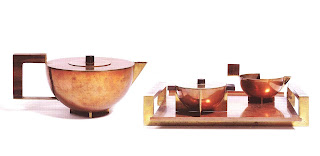
This four piece tea service includes a teapot, a cream jug, a sugar basin and a tray. The set is made of brass and copper with wooden handles. The construction of this tea service, along with the materials used, is exemplary of the work that was produced by the Bauhaus. The form as well as the some of the design attributes such as the “X” feet, the lids and the finials are very similar to other works specifically designed by Brandt but the rectilinear and angular handles, not seen in other objects of this nature, make this tea service very rare and unusual.
Marianna Brandt (1893-1983) joined the Bauhaus metal workshop in 1923, during which time it was under the guidance of László Moholy-Nagy, the Hungarian- born artist and graphic designer. However, prior to joining the art school, in 1917, Brandt had opened her own design studio. Moholy-Nagy’s influence on her work can be seen in the severe geometric forms of the household objects, such as ashtrays, lamps and tea and coffee services, which she designed. Moholy-Nagy recognized the young designer’s talents immediately and she soon became his assistant. In 1928 she succeeded her mentor and became the department’s first female director. Her involvement with the Bauhaus ended in 1932. While she was mostly unemployed during the war, she taught in various institutions in Dresden and Berlin during the late 1940’s and 1950’s. Some of her designs are still produced today by companies such as Alessi and Tecnolumen.
This tea service is central to our exhibition on Art Deco because it demonstrates the different strands of this important movement that took place in the early part of the twentieth-century. While the Art Deco period if often associated with glamorous, expensive and luxurious interiors full of elegant furniture made of exotic woods and classically inspired glass and ceramics, there was also another more somber and functional feature of this movement, which was influenced by Constructivist and Cubist art. The Brandt tea service embodies this latter category. We invite you to visit us and explore the beauty of this time period and the works of the many talented designers who contributed to it.
Bella Neyman
This article and the images in it are copyright- protected, and may not be excerpted or reproduced in any form without the consent of Primavera Gallery NY.


